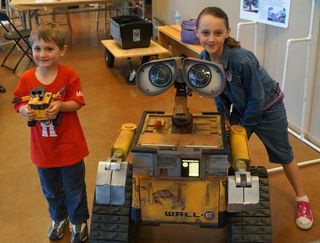Pixar's Wall-E Brought to Life by California Farmer
Members of the Wall-E Builder's Club on Yahoo have been busy building scaled replicas of everyone's favorite, trash-picking robot, Wall-E.

Move over R2D2, there's a new robot in town whose geek appeal is only matched by his adorably over-sized eyes. Wall-E the robot from the eponymous animated movie has been brought to life thanks to Mike McMaster and the other members of the Wall-E Builder's Club.
McMaster and his friends — most of whom are also members of the R2D2 Builder's Club — started working on their own versions of Disney Pixar's charming robot shortly before the film hit theaters in 2008.
MORE: Watch It! The 5 Coolest Robots
McMaster and his life-sized, remote-controlled Wall-E were interviewed recently by Tested.com and featured as a part of YouTube's first annual "Geek Week" (August 4-10).
From his orange farm in Bakersfield, Calif., McMaster described the process of assembling a built-to-scale replica of a robot that hitherto existed only as a computer-generated image (CGI).
He and his fellow builders used a combination of screenshot images, movie posters and BluRay still shots to gather an accurate portrait of the animated Wall-E.
Builder's club members then used other objects in the Wall-E movie to help determine the proper dimensions for their robot. McMaster said they started by looking at how big Wall-E's hands were in relation to a VHS tape or a Rubric's cube the robot handles in the movie, for example.
Sign up to get the BEST of Tom's Guide direct to your inbox.
Here at Tom’s Guide our expert editors are committed to bringing you the best news, reviews and guides to help you stay informed and ahead of the curve!
"We started with the hands and sort of worked our way backwards," McMaster said. "Once we had that scaled we were able to extrapolate how big the hands were in relation to the body, how big the body was in relation to the head."
The builders have since learned from speaking with Pixar animators that their one-to-one scaled model of Wall-E is actually quite accurate.
MORE: How Possible are the Giant Robots in 'Pacific Rim'?
http://www.technewsdaily.com/18529-giant-robots-possible-pacific-rim.html
McMaster and fellow builder, Mike Senna worked together to create all of Wall-E's parts from scratch. McMaster even custom built each of the treads that make up the robot's track drive wheels.
"The track drive turned out to be very problematic," McMaster said, "Because we wanted it to look the way it does in the movie, but it still had to work in the real world. And of course, in CGI you don't have to worry about real world physics and making things operate properly."
But McMaster's Wall-E does operate properly. Its head, which moves up and down enthusiastically, is powered by servos, tiny motors that have many applications in the world of robotics. His arms move up and down thanks to a linear actuator (the same thing that opens and closes the tray on a DVD or Blu-ray player), and his hands can even wave with help from a small gear motor.
While McMaster's Wall-E might look a little beat up, that's only because the builder wanted to remain true to the robot's animated image. He used special painting techniques— gleaned from YouTube videos and some friends in the prop-making business— to make Wall-E look weathered.
All of Wall-E's features are remote controlled, from his 270 degree vision and super-expressive eyebrows to his warbly robot voice and accompanying romantic soundtrack.
This adventurous little robot does like to get out of the house. McMaster has brought his Wall-E to the Walt Disney Family Museum in San Francisco as well as that city's annual Maker Faire.
And fellow Wall-E builder Mike Senna uses his replica of Wall-E to entertain kids all over his home state of California. Most recently, Senna's Wall-E made an appearance at the Muscular Dystrophy Association's summer camp in Orange, Calif., and he also makes frequent visits to Orange County's Children Hospital.
McMaster and Senna recently told the Washington Post that the smiles they see on kids' faces when Wall-E rolls into the room is reason enough to keep building and improving these lovable bots.
Follow Elizabeth Palermo on Twitter @techEpalermo or on Google+. Follow us @tomsguide, on Facebook and on Google+.
Elizabeth is a Live Science associate editor who writes about science and technology. She graduated with a bachelor of arts degree from George Washington University and has also written for Space.com, Everyday Health, Yahoo and Tom's Guide, among others. Elizabeth has traveled throughout the Americas, studying political systems and indigenous cultures and teaching English to students of all ages.
